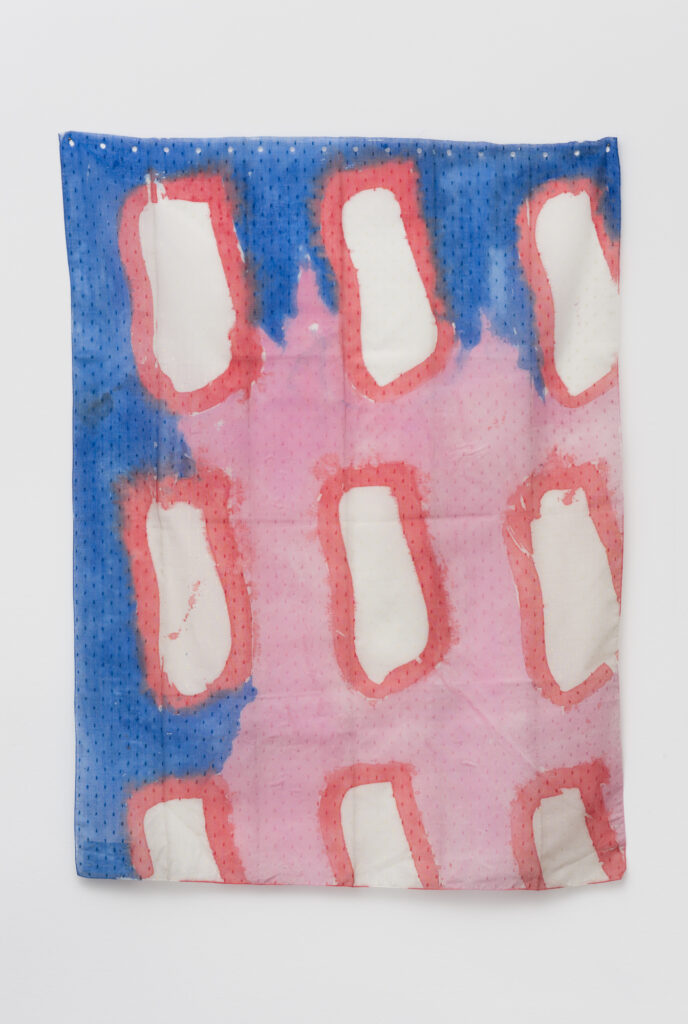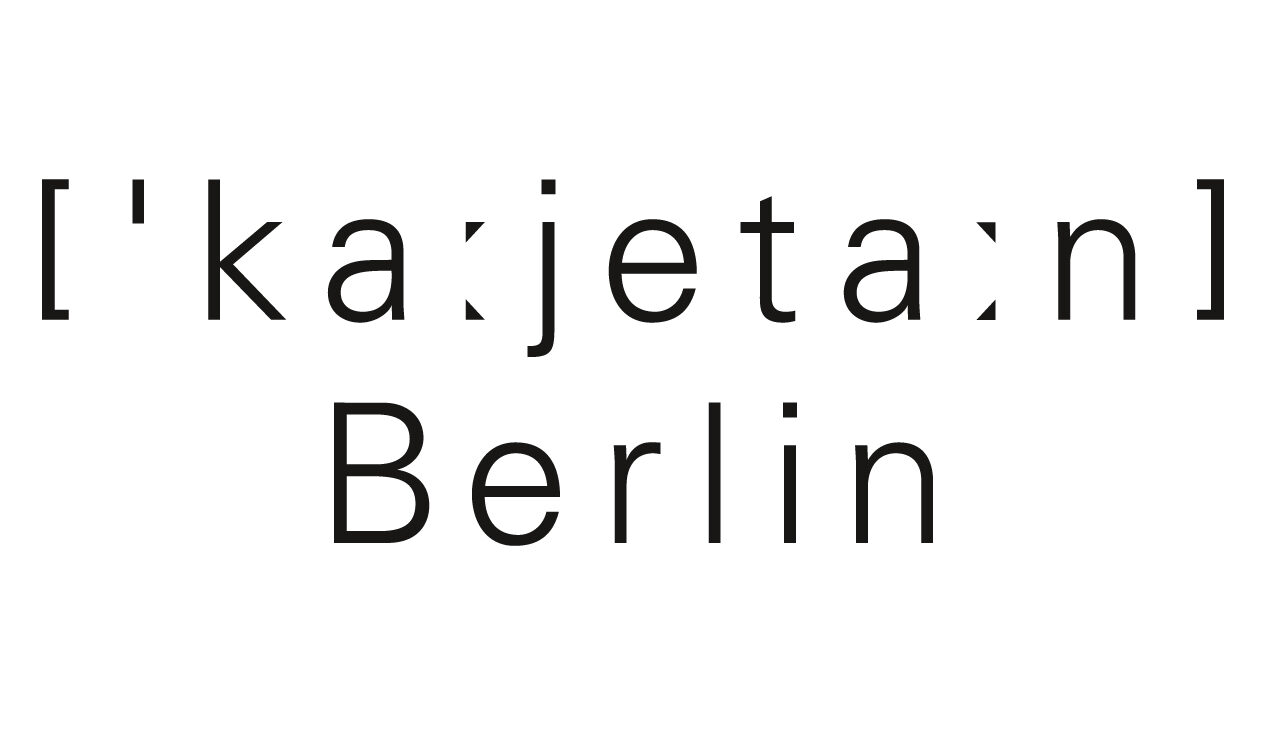4 December 2021 – 5 February 2022
In Berlin zeigt CLAUDE VIALLAT Stoffmalereien
Very brief review by Jens Hinrichsen about our exhibition Malereien II
monopol | Magazin für Kunst und Leben | Januar 2022
Gib mir ein Zelt zum Malen
Brief review by Jens Hinrichsen about our exhibition Malereien II
Tagesspiegel, 4 December 2021
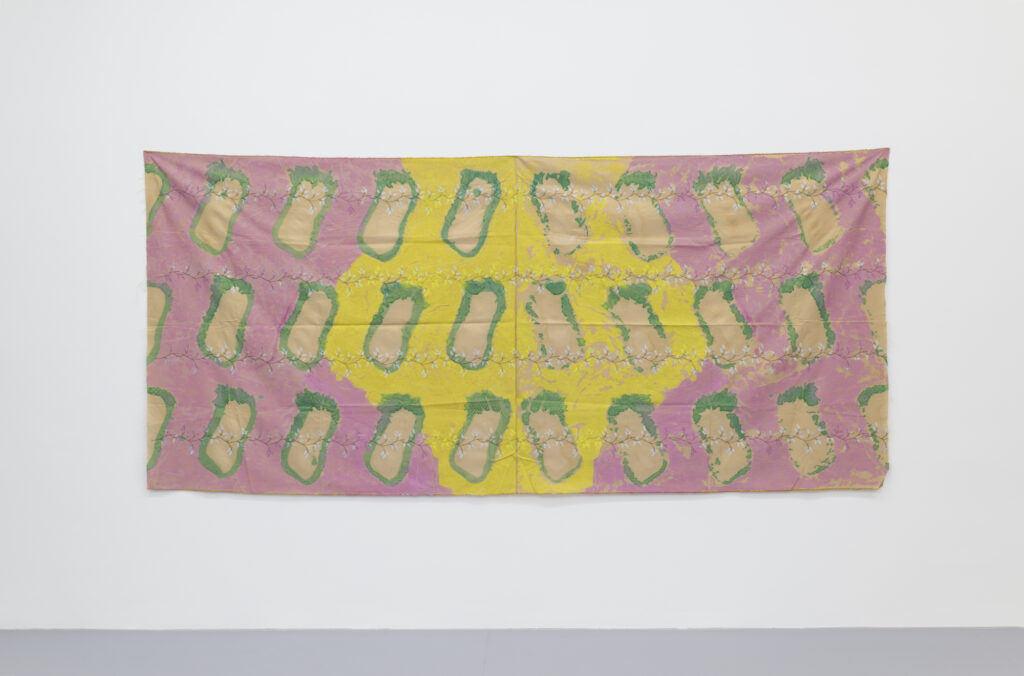
Die Galerie kajetan freut sich, mit Malereien II die nunmehr zweite Einzelausstellung des Wegbereiters der französischen Avantgarde-Bewegung Supports/Surfaces und Virtuosen der malerischen Selbstbezüglichkeit Claude Viallat präsentieren zu dürfen. Bereits in den 1960er-Jahren hinterfragte der aus Nîmes stammende und hier arbeitende Künstler das Medium der Malerei und seine Grenzen. So löste er die Leinwand von ihrem Keilrahmen, bemalte vorgefundene und mitunter gebrauchte Stoffe industrieller Herstellung, um sie am Ende mit einer eigenständigen, weder organischen noch geometrischen Form komplett zu überziehen – eine Form, die seine spannungsvollen Stoff-Malereien bis heute prägt. Die Galerie zeigt eine Auswahl seiner jüngsten Arbeiten.
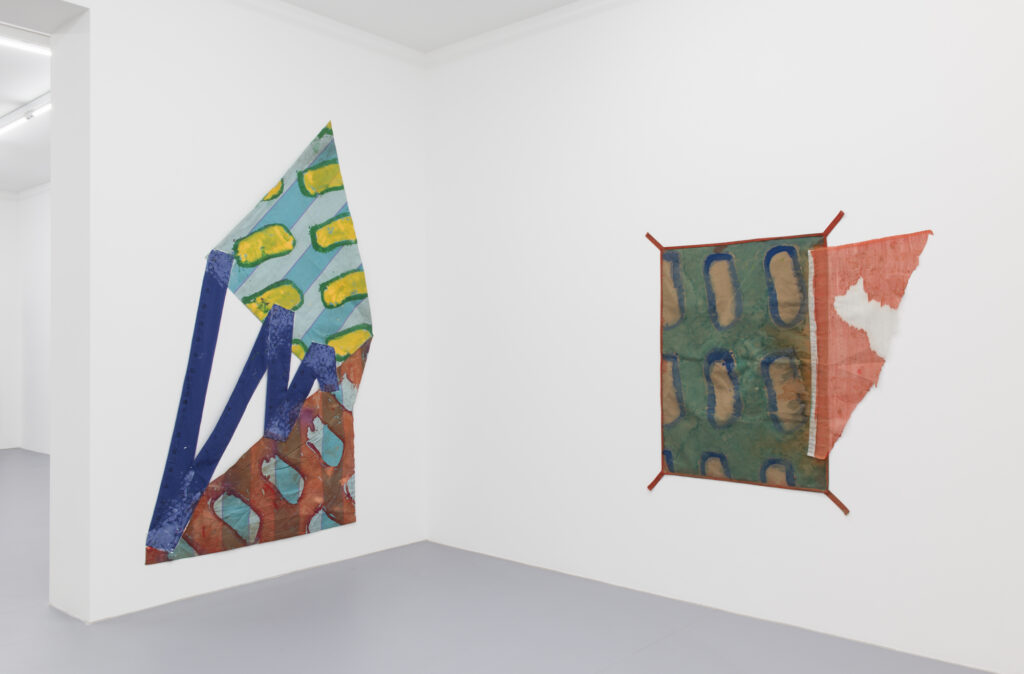
Galerie kajetan is pleased to present Malereien II, the second solo exhibition in Berlin of Claude Viallat, pioneer of the French avant-garde movement Supports/Surfaces and virtuoso of painterly self-reference. Already in the 1960s, the artist originating from and working in Nîmes questioned the medium of painting and its limits. He detached the canvas from its stretcher, painted on found and sometimes used fabrics of industrial manufacture in order to completely cover them in the end with an independent, neither organic nor geometric form – a form that still characterises his powerful fabric paintings today. The gallery shows a selection of his most recent works.
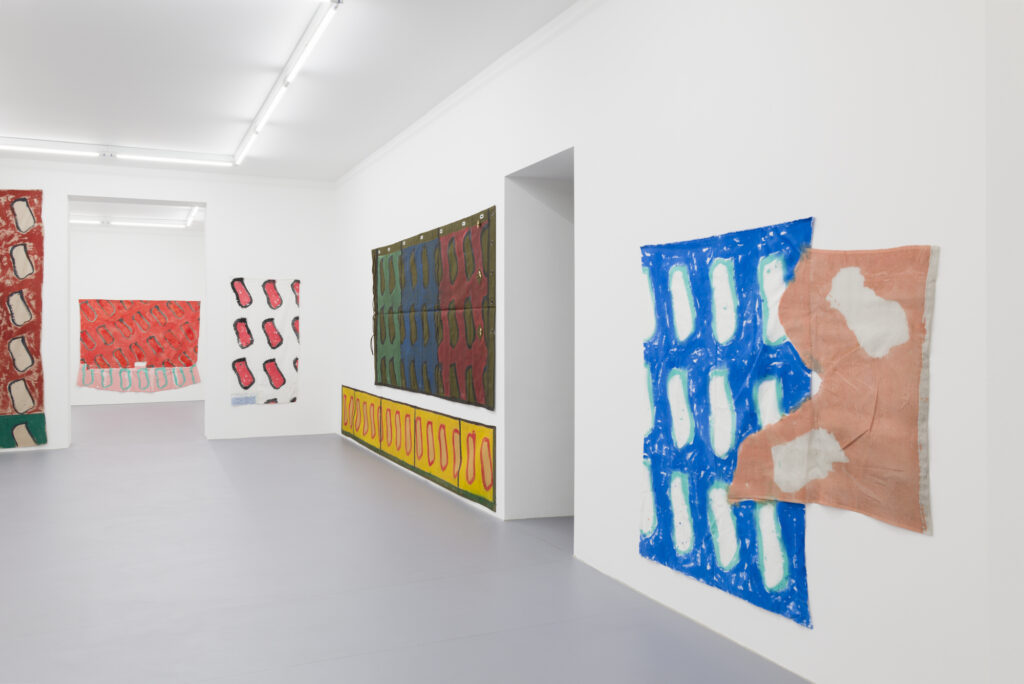
Nahezu verkleidet, in kaleidoskopischer Farb- und Formatfülle präsentieren sich uns die Galerieräume, die Claude Viallats ebenso komplexes wie formreduziertes malerisches Wirken dokumentieren. Ein Fundus an vielfältigsten, dem täglichen Gebrauch entzogenen Stoffen, die dem Künstler als Malgründe für das ihm typische Formenmuster dienen, welches bereits früh zu seiner Signatur wurde. Ob Tischdecken, gemusterte Bettlaken, Zeltplanen oder Filzbahnen – Viallat erhebt jedes noch so profan scheinende Textil zum ebenbürtigen Träger seiner fulminanten Allover-Malerei.
Bei den ungewöhnlichen Bildträgern handelt es sich heute überwiegend um Schenkungen, um Gebrauchsstoffe, die für die einstigen Besitzer ihre Zweckdienlichkeit verloren haben oder um neuwertige Restposten, die dem Verwertungskreislauf entzogen sind. Wertfrei sammelt der Künstler alle Stoffe unsortiert in seinem Atelier, bis er sie in seinen tagtäglichen Schaffensphasen malerisch-konzeptuell wiederbelebt. Dabei kennzeichnet ein analytischer, stets ergebnisoffener Zugang seinen Arbeitsprozess – es ist die Qualität der Ausgangsstoffe selbst, ihr Erhaltungsgrad, ihre materielle Dichte, Farbigkeit und Ornamentik, auf die der Künstler mit einer breiten Farbpalette reagiert.
Der individualisierte Zugriff auf die einzelnen Malgründe erscheint zunächst im Widerspruch zu Viallats über die Jahre perfektioniertem, wiederkehrendem Formenraster. Doch ist es gerade dessen Grundform – das einst durch Zufall gefundene, an seinen Ecken abgerundete Gebilde –, die es ihm erlaubt, nach eingehender Analyse auf die Besonderheiten des Trägers künstlerisch zu reagieren und nicht etwa umgekehrt, künstlerische Motive undifferenziert auf den Bildträger zu bannen. Anhand von Stempel und Schablone trägt Viallat Acrylfarbe mal stärker, mal verdünnter auf die am Boden lose ausgelegten Stoffe auf. Dabei gilt das künstlerische Interesse der jeweils unterschiedlichen Reaktion des Trägers auf die Malerei und den daraus resultierenden, stets neuartigen Bildfindungen.
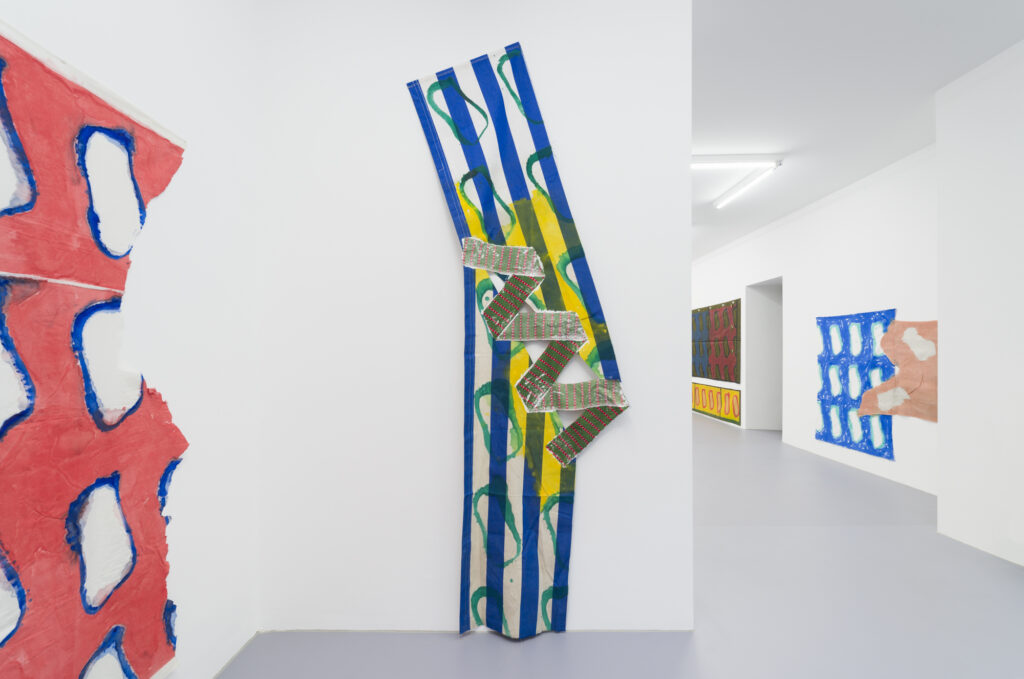
Damit verkehrt der Künstler seit bereits mehr als 50 Jahren Prozesse der malerischen Bildproduktion, die sich fortan nicht mehr eines neutralen Malgrunds, so etwa einer grundierten Leinwand bemächtigt, die es zu bedecken gilt. Vielmehr legt Viallat die zentralen Bildelemente frei und begreift die Malerei in ihrer reinen Materialität, die mit dem Malgrund interagiert und ihn so als gleichwertiges Gestaltungselement ausweist. Folglich lässt sich seine netzartig auf das Material schablonierte Form als Gegenform lesen. Während der serielle Verbund der Grundform den Bildträger strukturiert, konturieren die Flächen des Malgrunds die einzelnen Module. Einem Kippbild ähnlich, konfrontiert uns Viallat so mit zwei möglichen, dabei gleichwertigen Betrachtungen seiner einzelnen Bildfindungen und transferiert die Form-Inhalt-Debatte der Supports/Surfaces-Bewegung* der frühen 1970er Jahre konsequent in die Gegenwart.
Die konstitutiven Elemente eines Bildes zu dessen Inhalt erklärend, minimiert Viallat mittels schabloniertem Farbauf-trag alles Gestische und schärft unseren Blick für die Bildkonstruktion und den Malprozess, seine Bedingungen und Bestimmungen. Gebrauchsspuren der Ausgangsmaterialien, Spuren ehemaliger Installationen wie auch die des Transports und der Lagerung schreiben sich in Form von Stofffalten in seine Bilder mit ein. Sie treten an die Seite seiner Allover-Malerei, die sich einer Blickführung des Betrachters verweigert. Wenngleich die Orientierung der Grundform, ihre diagonale Ausrichtung, festgelegt ist, so bieten seine Patchwork-Arbeiten häufig mindestens zwei unterschiedliche Möglichkeiten der Hängung oder einzelne Stücke gleichwertige Recto-Verso-Ansichten. Bis heute bricht der Künstler damit radikal mit unseren Sehgewohnheiten und Erwartungen an die Malerei.
Dank dieser konzeptuellen Stringenz blicken wir auf ein Œuvre, das hierarchische Strukturen raffiniert aufbricht, vermeintliche Grenzen immer wieder sprengt und so Hoch- und Gebrauchskunst zu einem pulsierenden, sich selbst vermittelnden Bild vereint.
Claude Viallat zählt international zu den grossen Erneuerern der zeitgenössischen Kunst. Seine Werke wurden in renommierten Ausstellungshäusern gezeigt, so u.a. im MOMA, New York, im Centre Pompidou in Paris, im Museum moderner Kunst Stiftung Ludwig, Wien, im Musée des Beaux Arts in Montréal oder im National Museum of Art in Osaka. Im Jahr 1988 hat er Frankreich auf der Biennale in Venedig vertreten.
Eliza Grabarek M.A.
*Die französische Künstlergruppe Supports/Surfaces wurde von Daniel Dezeuze, Patrick Saytour und Claude Viallat begründet. Sie konzentrierte sich auf die Auslotung unterschiedlicher Ausdrucksformen mittels Bildträger (franz.: support) und Bildoberfläche (franz.: surface). Die Hauptschaffenszeit der Gruppe lag zwischen 1970 und 1974. „Dezeuse hat Rahmen ohne Leinwand bemalt, ich habe Leinwände ohne Rahmen bemalt und Saytour hat das Bild eines Rahmens auf Leinwand gemalt.“ (Claude Viallat)

Almost disguised, in a kaleidoscopic abundance of colour and format, the gallery spaces present themselves, documenting Claude Viallat’s painterly work, which is as complex as it is reduced in its form. A treasure trove of the most diverse fabrics, removed from everyday use, which serve the artist as painting grounds for his typical pattern of templates, having become his signature. Whether tablecloths, patterned bed sheets, tent tarpaulins or felt sheets – Viallat equally elevates every textile, no matter how seemingly mundane, to a carrier of his splendid all-over painting.
Today, his unusual picture carriers are mainly donations, everyday materials that have lost their usefulness for their former owners or new remnants that have been withdrawn from the recycling circuit. Value-free, the artist collects all the materials unsorted in his studio, until he revives them in his daily creative phases in a painterly and conceptual way. His working process is characterised by an analytical approach that is always open-ended – it is the quality of the base fabrics themselves, their degree of conservation, fabric density, colourfulness and ornamentation, to which the artist reacts with a broad palette of colours.
Initially, the individualised approach to the single painting grounds appears to contradict Viallat’s recurring grid of forms, which he has perfected over the years. But it is precisely its basic form – the shape once found by chance, rounded at its corners –, that allows him to react artistically to the particularities of the carrying fabric after in-depth analysis and not, for example, the other way round, to capture artistic motifs in an undistinguished way on the picture support. Using stamps and stencils, Viallat applies acrylic paint sometimes thicker, other times thinner to the fabrics loosely spread out on the floor. In his artistic practice he focuses on the variety of reactions of the fabric base to the painting, always resulting in advanced pictorial inventions.
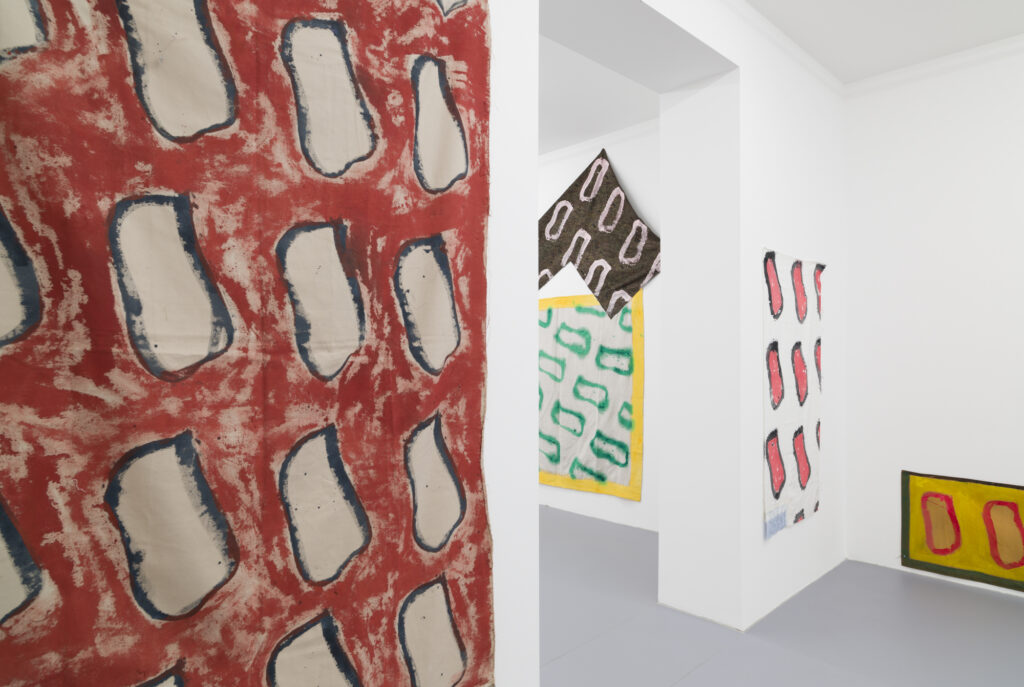
In this way, the artist has been revaluating the process of painterly image production for more than 50 years, which from now on no longer takes possession of a neutral painting ground such as a primed canvas, which has to be covered by the artist. Rather, Viallat exposes the central pictorial elements and understands painting in its pure materiality, which interacts with the painting ground and thus identifies it as an equal creative element. Consequently, his net-like form repeatedly applied onto the fabric can be read as a counter-form. While the serial compound of the basic form structures the image base, the surfaces of the painting ground on their turn contour the individual modules. Similar to a visually ambiguous picture, Viallat thus confronts us with at least two possible, yet equally valid views of his individual pictorial inventions and consistently transfers the form and content debate of the Supports/Surfaces movement* of the early 1970s into the present.
Declaring the fundamental elements of a picture to be its content, Viallat minimises everything gestural by means of repeated paint application and sharpens our eye for the construction of the picture and the process of painting, its conditions and determinations. Traces of usage of the original textiles or by former installations as well as those of transport and storage inscribe themselves in his paintings in the form of fabric folds. They come alongside his all-over painting, which refuses to guide the viewer’s gaze. Although the orientation by the basic form, its diagonal alignment, is fixed, his patchwork pieces often offer at least two different possibilities of hanging or singular works offer equivalent recto-verso views. To date, the artist thus radically breaks with our visual conventions and expectations of painting.
Thanks to this conceptual stringency, we are looking at an œuvre that ingeniously tears down hierarchical structures, repeatedly shatters presumed boundaries and thus unites high art and applied art into a pulsating, self-mediating image.
Claude Viallat is one of the most significant international innovators of contemporary art. His works have been shown in renowned institutions, including the MOMA, New York, the Centre Pompidou in Paris, the Museum moderner Kunst Stiftung Ludwig, Vienna, the Musée des Beaux Arts in Montréal and the National Museum of Art in Osaka. In 1988, he represented France at the Venice Biennial.
Eliza Grabarek M.A.
*The French artist group Supports/Surfaces was founded by Daniel Dezeuze, Patrick Saytour and Claude Viallat. They focused on the exploration of different forms of expression by means of the image carrier (French: support) and the image surface (French: surface). The group’s main creative period was between 1970 and 1974. „Dezeuse painted frames without canvas, I painted canvases without frames and Saytour painted the image of a frame on canvas.“ (Claude Viallat)
